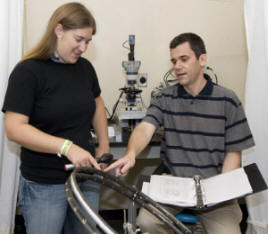|
In our
lab, we are interested in understanding the factors that
shaped the evolution of visual systems in birds. This is
a complicated riddle to solve due to the many potential
factors (predation, food types, light levels, habitat
type, etc.) that could have played some role. However,
we take a baby-step approach. In this first phase, we
are looking at the relative role of two factors:
(a) using
the visual systems to reduce predation. For instance,
some species (ducks) have their eyes laterally placed,
which would allow them to detect predators from
different spots around their heads even when head down
foraging.
(b) using
the visual systems to improve the ability to find and
capture food. For instance, some species have their eyes
placed frontally, which increases the degree of
binocular overlap, and likely the ability to capture
prey. These species tend to have lower predation
pressure, and are predators themselves.

We answer
this question using a comparative approach, which means
studying the relationship between visuals systems and
the behavior of many different bird species. We first
characterize some aspects of the visual systems (visual
fields, visual acuity, eye movements, color vision) and
then study bird foraging and anti-predator behavior.

Previous:
Visual systems
Next:
Measuring visual systems
|